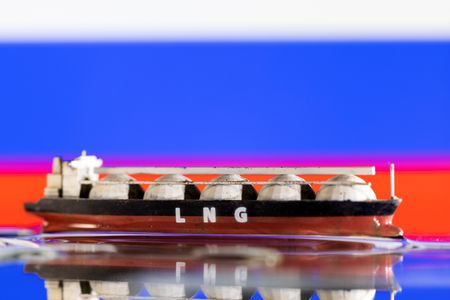By Yuka Obayashi
TOKYO (Reuters) – Japan, the world’s top liquefied natural gas (LNG) importer, is facing its latest challenge in securing vital gas supplies from Russia after Western reinsurers said they would halt marine war insurance for ships travelling in Russian waters from Jan. 1.
Having joined other G7 countries in imposing sweeping sanctions on Moscow for the invasion of Ukraine, Japan has been reducing its reliance on Russian oil and coal, but it continues to buy Russian LNG amid elevated prices in a tight global market as Europe ramps up imports.
WHICH COMPANIES ARE AFFECTED?
Japan’s Tokio Marine & Nichido Fire Insurance, Sompo Japan Insurance and Mitsui Sumitomo Insurance told shipowners last week that from Jan. 1 they would stop offering insurance coverage for ship damage caused by war in Russian waters, because reinsurers were withdrawing coverage. Without the war insurance, shippers such as Mitsui OSK Lines and Nippon Yusen might have to halt operations in Russian waters, including loading LNG from the Sakhalin-2 complex in Russia’s Far East, industry sources said. Japan receives 9% of its imported LNG from Sakhalin-2, which is owned by Gazprom and Japanese trading houses.
Loss of supply from Sakhalin-2 could send Japanese power and gas utilities such as JERA and Tokyo Gas Co Ltd scrambling for alternatives.
The country has already faced repeated challenges in securing gas supplies since Russia sent its armed forces into Ukraine in February. It has had to persuade G7 partners to give it leeway so it could keep importing Russian LNG, and after the Russian government decided in June to seize control of Sakhalin-2, Japanese trading houses had to agree to remain as shareholders of the new Russian operator.
WHAT ACTIONS HAVE BEEN TAKEN?
To avoid supply disruption, the three Japanese insurers are negotiating with various reinsurers to retain the war coverage.
In a rare joint letter, Japan’s Financial Services Agency and Agency for Natural Resources and Energy have also asked insurers to take on additional risks to continue providing marine war insurance for shippers transporting LNG from the Sakhalin-2.
“The top priority now is to secure marine war insurance,” a senior official at the industry ministry said.
It is still unclear whether the insurers can secure sufficient reinsurance, especially at a time when many Western counterparts are away on holidays.
WHAT ARE THE OTHER OPTIONS?
Shipowners may continue operations without the war coverage by shouldering the risks, since voyages between Sakhalin island and Japan are short, taking just a few days, and since the LNG export facility is located far from the battlefields of Russia and Ukraine.
However, they risk losing their tankers to seizure in Russia for some unforeseeable reason. Each LNG tanker costs 20 billion to 30 billion yen ($150 million to $220 million).
Other parties, such as the government and Japanese utilities, the buyers of the Sakhalin fuel, might have to share the risk, industry sources said, although sources in the government and among buyers said they were not yet considering such a move.
“Insurers and shipping companies are trying to resolve the issues and we are closely watching the situation,” a source at a utility said.
Another option would be to use a sovereign liability guarantee, like the one that covered shipments of Iranian oil to Japan in 2012, after Western insurers cut cover due to sanctions on Iran.
Legislation that authorised that guarantee was for Iranian oil imports only, so new law would be needed for guarantees covering shipments from Russia, the ministry official said.
WHAT IS THE RISK FOR JAPAN’S GAS AND POWER SUPPLIES?
The clock is ticking, but any immediate risk of fuel and power shortages looks small, even if some LNG cargoes are delayed early next month, another source at a power utility said. The reason was that stocks built up ahead of the peak winter demand season were larger than usual, that source said.
LNG inventories at Japan’s major power utilities were 2.41 million tonnes on Dec. 25, above the five-year average of 1.84 million tonnes for the same time of year, according to industry ministry data.
Also, Japan has created a new mechanism to allow the industry ministry to help redirect supplies of LNG in the event of an emergency so gas and power companies do not run short.
If supply from Sakhalin-2 is disrupted, buyers can exercise the upward quantity tolerance clause typically found in long-term contracts, allowing them to request 5% to 10% additional volumes from suppliers elsewhere.
A source at an urban gas provider said his company could also get alternative supply from the spot market if it could accept the higher price there.
Japanese buyers paid $15.78 per million British thermal units (mmBtu) for Russian LNG in November, below the average price of imported LNG of $17.86 and an average spot-cargo price for delivery to Japan of $18.40, according to the Japan Organization for Metals and Energy Security.
The average LNG price for February delivery to northeast Asia is around $31 per mmBtu.
Japan uses LNG for 39% of its electricity generation.
(Reporting by Yuka Obayashi; Editing by Florence Tan and Bradley Perrett)








